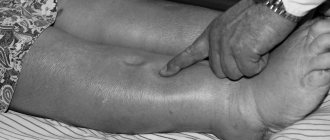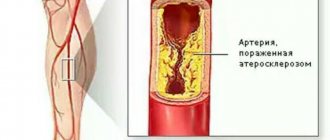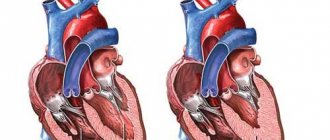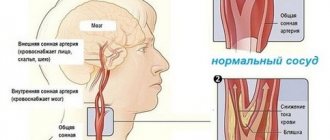Characteristics of hypercapnia
Hypercapnia is an increase in the level of carbon dioxide in the blood and tissues of a person. There is another name for the condition - hypercarbia.
Based on the nature of their origin, two forms are distinguished:
- Endogenous - changes occurring in the human body as a result of exposure to pathologies accompanied by respiratory failure.
- Exogenous - prolonged exposure to conditions with high concentrations of carbon dioxide.
Hypercapnia - an increase in the amount of carbon dioxide in the blood
The acid-base balance is of great importance. When the pressure of carbon dioxide in the blood increases, the balance is disrupted - acidity increases.
Video about the process of gas exchange in the lungs
Causes of hypercapnia
The following reasons lead to the formation of a pathological condition:
- Changes in breathing as a result of:
- scoliosis;
- pneumosclerosis;
- chest injuries;
- Pickwick's syndrome;
- weakness of peripheral skeletal muscles (with muscular dystrophy and other conditions);
- obesity.
- Depression of the respiratory center due to factors:
- CNS lesions;
- use of medications (inhalation, anesthetics);
- circulatory arrest.
- Gas exchange disorders occurring in the following diseases and situations:
- pleurisy;
- pneumothorax;
- hyperthermia of a malignant nature;
- sepsis;
- chronic obstructive pulmonary disease;
- Hamman-Rich disease;
- entry of stomach contents into the respiratory tract;
- respiratory distress syndrome.
Damage to one or more elements of the lungs leads to deterioration of breathing and increased concentrations of carbon dioxide
The formation of exogenous forms of hypercapnia is associated with the following factors:
- improper breathing;
- hyperventilation (excess oxygen saturation) when diving to great depths (during diving) or after oxygen therapy;
- prolonged stay in rooms with poor ventilation;
- increased concentration of carbon dioxide during a fire;
- malfunctions of equipment used during surgery.
Many people who dive conserve oxygen by exhaling infrequently. Such an error will make itself felt after some time in the form of the development of hypercapnia.
Emergency medicine
External respiration disorders lead to gas exchange disorders in the lungs, which can manifest themselves in the form of three main syndromes: hypoxia , hypercapnia and hypocapnia.
Arterial blood normally contains 95-98% HbO2, O2 tension (pO2) is 100 mmHg. Art., CO2 voltage (pCO2) is 35-45 mm Hg. Art.
Hypoxia syndrome. If the HbO2 content in arterial blood is less than 95%, then this condition is called hypoxemia. Hypoxemia is a particular manifestation of the general hypoxia syndrome, i.e. oxygen deficiency in the body. Oxygen starvation, as is known, can be caused by disturbances in gas exchange in the lungs, disruption of oxygen transport in the blood or its utilization by tissues (see Chapter VI).
Clinically, there are three stages of hypoxia development.
The first stage is moderate hypoxia. Patients are restless, euphoric, and less often drowsy. There is mild cyanosis, breathing is rapid, the wings of the nose are swollen, the pulse is rapid, and blood pressure is moderately increased. Arterial blood contains 89-85% HbO2, pO2 -70-55 mm Hg. Art. (A. M. Charny, 1947).
The second stage is deep hypoxia . The patients are sharply excited. Cyanosis, breathing is rapid, additional respiratory muscles are involved in the act of inhalation, the pulse is very rapid, blood pressure is increased. At this stage, seizures and coma may occur. In arterial blood 87-74% HbO2, pO2 -55-40 mm Hg. Art. (A. M. Charny).
The third stage is hypoxic coma. Patients are unconscious and have no reflexes. Severe cyanosis, breathing rhythm is disturbed, periodic breathing may be observed, blood pressure drops sharply, cardiac activity is disrupted and death occurs. In arterial blood there is 40-30% HbO2, pO2 - 40-20 mm Hg. Art. (A. M. Cherny).
Hypercapnia syndrome - the body has an increased level of carbon dioxide, pCO2 in arterial blood is above 40 mm Hg. Art. With hypercapnia, gas or respiratory acidosis develops, which can be compensated or uncompensated. Clinically, there are three stages of hypercapnia development.
The first stage is moderate hypercapnia. Patients are in a state of euphoria and sleep poorly. The skin is hyperemic, sweating is moderately increased, breathing is rapid, bronchial secretion is increased, pulse is rapid, blood pressure is increased.
The second stage is deep hypercapnia. Patients are sharply excited and aggressive. Skin with a cyanotic tint, profuse sweating. Carbon dioxide is normally a natural stimulant for the cells of the respiratory center. However, an increase in the carbon dioxide content in arterial blood leads to depression of the respiratory center, as a result of which breathing becomes rare and shallow, and the breathing rhythm is disrupted. Bronchial secretion is sharply increased, the pulse is above 160 beats per minute, blood pressure is increased, tissue bleeding is increased, and urine formation is reduced.
The third stage is acidotic coma. Patients lack consciousness and reflexes. The skin is cyanotic, blood pressure is sharply reduced. Coma develops gradually and death occurs from respiratory arrest or cessation of cardiac activity.
Hypocapnia syndrome - the carbon dioxide content in the arterial blood is reduced, the carbon dioxide tension is less than 40 mm Hg. Art. Hypocapnia develops with an increase in alveolar ventilation, which often occurs when the central regulation of breathing is disturbed and during hypoxia of various origins. Hypocapnia itself can lead to hypoxia due to difficulty in dissociating oxyhemoglobin.
With significant hypocapnia, patients are lethargic, drowsy, and apathetic. The skin is pale and dry, blood pressure is low, the pulse is frequent, the urine reaction is alkaline due to increased excretion of bicarbonates by the kidneys. With hypocapnia, gas alkalosis develops, which can lead to cerebral vasospasm.
Due to a decrease in the content of calcium ions in the blood with an increase in gas alkalosis, a convulsive syndrome develops - tremor of facial muscles, athetosis of the fingers, increased tone of the respiratory muscles (N. E. Burov, etc.) Then an alkalotic coma occurs, which quickly leads to death.
Fundamentals of resuscitation, ed. V.A. Negovsky, 1975
Early and late symptoms of pathology
Early clinical manifestations are represented by dilation of peripheral blood vessels, which leads to increased sweating and redness of the patient’s skin. An increase in carbon dioxide levels causes the activation of compensatory mechanisms, which is why symptoms arise:
- pale skin;
- increased venous tone;
- increase in stroke volume of the heart;
- tachycardia.
Late signs are associated with the process of decompensation in the cardiovascular, nervous and respiratory systems, which is manifested by symptoms:
- sticky and profuse sweating;
- blueness of the skin;
- lethargy or overexcitement.
Signs of poisoning appear when the concentration of carbon dioxide increases by more than 5%. The lethal dose is considered to be 30%.
Hypercapnia during pregnancy
During pregnancy, the body requires more oxygen, so the need for it increases by about 20%. At the same time, the woman’s breathing pattern changes, which is associated with the growth of the uterus. Using the abdominal press becomes impossible; inhalation and exhalation is carried out through the use of the pectoral muscles.
The situation is aggravated by the pressure of the uterus on neighboring organs, so a deep breath is impossible due to the high position of the diaphragm. Thus, pregnant women need to closely monitor their condition, as the likelihood of hypercapnia increases significantly.
Features of the pathological condition in childhood
The respiratory system of a child is more susceptible to the development of hypercapnia than that of an adult. This is due to the following reasons:
- weakness of the respiratory muscles;
- narrow respiratory passages - minor inflammation leads to their complete closure;
- an increased reaction of the body to irritation - spasms, mucus production and swelling also impair the breathing process.
Therefore, the pathological condition in children develops faster and is more severe.
Features of hypercapnia in children
In children, respiratory failure due to carbon dioxide poisoning develops faster and is more severe than in adults.
The specifics of the course and consequences of hypercapnia in childhood are associated with the anatomy and functionality of the respiratory system:
- narrow airways (cause disruption of their patency even with slight swelling or accumulation of mucus);
- rapid reaction of respiratory tract tissues to irritants (swelling, spasm, increased secretion);
- weakness of the respiratory muscles in children;
- anatomical features - abduction of the ribs from the sternum almost at a right angle reduces the depth of inspiration.
An increased level of carbon dioxide in the blood of a pregnant woman is a dangerous condition for both mother and child. Features that aggravate or provoke the development of hypercapnia:
- while carrying a baby, a woman’s need for oxygen increases by approximately 18–22%;
- as a result of the growth of the uterus, the abdominal type of breathing is replaced by the thoracic one, in which the abdominal muscles, as auxiliary ones, are excluded from participating in breathing, which leads to incomplete exhalation and the accumulation of carbon dioxide in the lungs;
- the growing uterus puts pressure on the liver, stomach, raises the diaphragm, reducing the tidal volume of the lungs and preventing the possibility of deepening the breath with the help of its movement.
All these changes contribute to the rapid development of respiratory acidosis even with minor disorders in the respiratory system.
Consequences:
- respiratory failure, increased blood pressure, increased viscosity or, conversely, its dilution with the risk of bleeding;
- high risk of developing eclampsia, early placental abruption;
- miscarriage, premature birth;
- hypoxia, respiratory failure in the fetus, newborn;
- disturbance of placental gas exchange;
- the negative impact of carbon dioxide on the central nervous system and cerebral cortex of the infant, leading to the development of the following pathologies: disorders of organ formation in the embryo;
- delayed mental and physical development in a newborn;
- cerebral palsy;
- epilepsy.
If the baby survives childbirth safely, then later he may develop severe chronic disorders. As a result, all newborns with respiratory acidosis require intensive treatment.
Adaptation of the body
The patient's body strives to get rid of oxygen deficiency and normalize blood circulation, so blood flow to the brain and heart increases. The process of adaptation of the respiratory system leads to the following results:
- increasing the minute volume of respiration;
- reducing carbon dioxide levels;
- restoration of acidity.
Changes in acidity lead to activation of renal mechanisms, which are characterized by:
- ammoniogenesis - removal of excess acids;
- secretion of protons;
- reabsorption of bicarbonate ions.
Reasons for the development of hypocapnia
Hyperventilation of the lungs is a condition characterized by a pathological increase in the frequency of respiratory movements, sometimes in combination with an increase in the depth of breathing (hyperventilation syndrome).
This pathological condition may have many causes at the basis of its genesis, the main ones of which include:
- Structural lesions of the central nervous system: tumors, injuries, cerebrovascular accidents;
- Inflammatory diseases of the brain - meningitis, encephalitis;
- Psychoneurological conditions are acute and chronic (not always diseases): stress, pain, overexcitation, fear, panic, hysteria, excessive joy and others;
- Medicinal substances and some toxins: caffeine, cordiamine, camphor, strychnine, salicylates, botulinum toxin;
- Decreased oxygen capacity of the blood: anemia, blood loss, carbon monoxide poisoning, smoking;
- Hyperthermia – increased body temperature;
- Irritation of the carotid sinus: access to its receptors of oxygen-poor blood, a small amount of blood, exposure to heavy metals and their salts, nicotine and other substances;
- Decreased partial pressure of oxygen in the inhaled air (mountain sickness);
- Thromboembolism of small branches of the pulmonary artery and pulmonary infarction;
- Obturation (closure) of single bronchi (lobar and segmental) with foreign bodies;
- Obstruction and swelling of the airways - bronchial asthma, aspiration syndrome, inhalation of vapors of irritating substances;
- Inadequate artificial ventilation.
Of no small importance in the development of hyperventilation and hypocapnia is the emerging vicious circle , which consists of successively changing interconnected reactions: a trigger or starting point (any of the causes of hypocapnia), the development of clinical manifestations, the formation of feelings of fear and overexcitation and, as a consequence, hyperventilation again, which closes the vicious circle . The fundamental fact is that after eliminating the trigger, an already running vicious circle can exist independently, which requires treatment aimed not only at the original source of hypocapnia, but also at breaking the formed vicious circle.
Hypocapnia, one of its pathophysiological effects, has gas (respiratory) alkalosis - a shift in the acid-base balance of the blood towards alkali, which has a number of pathophysiological effects that cause clinical manifestations:
- Pathological change in vascular tone: against the background of a decrease in the tone of peripheral vessels (muscles, skin, intestines), an increase in vascular tone in the brain and heart occurs, which together leads to a drop in blood pressure and a slight decrease in cardiac output;
- Forced diuresis, which leads to a drop in blood pressure, electrolyte disturbances and dehydration;
- Increased neuromuscular excitability;
- An increase in the affinity of hemoglobin for oxygen, which makes the bond of oxygen with hemoglobin stronger, thereby causing hemic hypoxia.
Ways to identify the problem
The patient’s condition is determined not only when symptoms of hypercapnia are detected during examination, but also using laboratory and instrumental research methods:
- blood test - identifying the level of bicarbonates in the serum, determining the concentration of carbon dioxide;
- aerotonometry - detection of gas tension;
- spirometry - assessment of external respiration;
- capnography - diagnostics of the amount of carbon dioxide in the patient’s exhalation.
Capnograph allows you to determine the amount of carbon dioxide
The effectiveness of capnography is based on the diffuse properties of carbon dioxide - the exhaled air will contain the same amount of the substance as in the patient’s blood.
Diagnostics
An experienced clinician will be able to make the correct diagnosis based on symptoms and laboratory results.
The doctor needs:
- study your medical history to look for a possible underlying disease;
- collect and analyze your life history to identify external causes, which will allow you to determine whether there was a need for a procedure such as permissive hypercapnia;
- assess the condition of the skin;
- measure pulse, heart rate and blood tone;
- interview the patient in detail (if the person is conscious) or the one who delivered the victim to a medical facility - to draw up a complete symptomatic picture and determine the severity of the condition.
Laboratory research:
- general clinical blood test;
- blood biochemistry;
- assessment of the gas composition of biological fluid;
- CBS analysis.
As for instrumental procedures, the following tests are performed:
- chest x-ray;
- ECG;
- ultrasonography;
- CT;
- MRI.
How is MRI performed?
Features of treatment
First aid to a patient
If signs of exogenous hypercapnia appear, the following is required:
- take the patient out into the fresh air or ventilate the room;
- provide the patient with plenty of fluids;
- loosen the collar of your clothing or tie.
In severe cases, tracheal intubation is performed - insertion of a special tube to ensure air flow. Artificial ventilation and oxygen therapy are also used, but care must be taken - excessive oxygen saturation leads to increased symptoms of hypercapnia, especially with drug poisoning and exacerbation of the chronic phase of the disease.
If you are prone to developing respiratory failure, it is useful to do the following:
- humidify the air in the room - special products or hanging wet towels are suitable;
- clear the airways of accumulated mucus.
Drug treatment of the patient
Depending on the severity of the development of hypercapnia, the following medications are prescribed:
- Bronchodilators (Aminophylline, Eufillin, Salbutamol) - improve lung ventilation.
- Diuretics (Torasemide, Cyclomethiazide, Furosemide) - increase the compliance of the lungs, promoting the flow of more oxygen.
- Alkaline solutions (Tromethamine, Carbicarb) - used for severe conditions.
- Physical solution - promotes the removal of bronchial secretions.
Medicines gallery
Salbutamol is a bronchodilator drug
Furosemide increases lung compliance
Eufillin improves breathing
Folk remedies for improving breathing
Traditional recipes are suitable for early-stage respiratory failure. Such remedies help remove mucus and expand the bronchi, thereby eliminating obstacles to breathing.
Vegetable juices not only thin mucus, but also strengthen the body:
- Beetroot juice - leave for 3 hours in the refrigerator and drink half a glass. The drink eliminates the manifestations of intoxication.
- Cabbage juice - add a little sugar to improve the taste. The product has expectorant properties.
- Carrot juice has an anti-inflammatory effect and prevents stagnation of phlegm in the bronchi.
Breast collection is also aimed at improving the removal of mucus and strengthening the body, as it consists of the following components:
- licorice root;
- sage;
- marshmallow roots;
- plantain;
- oregano herbs;
- coltsfoot.
To prepare the medicine you need:
- Pour 1 tbsp. l. collecting in dishes.
- Pour a glass of water.
- Heat for 15 minutes in a water bath.
- Leave for 45 minutes.
- Strain and squeeze out the product.
- Add a glass of water.
The medicine is taken 4 times a day.
If you purchased a pharmacy version of a breast collection, then the brewing procedure occurs in the following way:
- Place 1 collection bag in a container.
- Pour 200 ml of boiling water over the product.
- Leave for 25 minutes.
It is necessary to take the breast milk 3 times a day.
Gallery of folk remedies
Cabbage juice has expectorant properties
Carrot juice has anti-inflammatory effects
Beet juice reduces carbon dioxide poisoning
Use of inhalations
Respiratory failure can develop against the background of a runny nose, bronchitis and other diseases that impair the supply of oxygen to the body. It is useful to use inhalations in such cases, as they act on the source of inflammation and reduce the severity of symptoms. The following options for the procedure are available:
- Using essential oils - add a small amount of the substance to a container of hot water. During treatment, the patient inhales steam containing medicinal components, then the oils of the following plants can improve his well-being:
- calendula;
- eucalyptus;
- chamomile;
- sage;
- coltsfoot;
- St. John's wort.
- Using a nebulizer - components are added to a special device. In addition to the listed plants, you can use bronchodilators.
Nebulizer - a convenient device for inhalation
To carry out inhalation, a consultation with a doctor is necessary—it is prohibited to select the dose of medication on your own. This also applies to the other treatment methods mentioned earlier.
The effect of the thyroid gland on blood pressure
Have you been trying to cure HYPERTENSION for many years?
Head of the Institute of Treatment: “You will be amazed at how easy it is to cure hypertension by taking it every day...
Read more "
Thyroid dysfunction and hypertension are closely related to each other. The organ produces many hormones that affect blood pressure. Hypertension due to hypothyroidism is a common problem. These are two serious diseases that require proper diagnosis and treatment.
What is hypothyroidism?
It is characterized by a condition when the thyroid gland produces hormones in insufficient quantities. There is a decrease in heart rate and heart rate. Blood vessel resistance causes hypertension in half the cases. Adrenaline levels rise. This condition is characterized by 2 signs:
- increased lower pressure;
- the upper pressure is not changed.
The lower threshold indicators characterize the degree of hypothyroidism. The disease is often accompanied by the following symptoms:
- hair fragility;
- memory loss;
- dry skin;
- lethargy.
If you have one of the symptoms, you should make an appointment with an endocrinologist.
Blood pressure and hypothyroidism
Blood pressure directly depends on thyroid hormones. Hormonal imbalance changes the tone of veins and arteries, heart rate. Without drug treatment, the patient's well-being worsens. The patient's performance decreases. Normalizing the functions of the thyroid gland will help eliminate the problem.
The thyroid gland is part of the endocrine system. It is this system that regulates blood pressure. Statistics show that about 20-30% of the adult population suffers from hypertension. Under normal conditions, an increase in thyroid hormones T3 and T4 occurs for several reasons:
- Stressful situations.
- Decrease in ambient temperature.
- Exercise stress.
When the thyroid gland overproduces the hormones T3 and T4, the condition is called hyperthyroidism. It affects the body in the following ways:
- Increased blood pressure. The heart muscle contracts more strongly, the lumen of the arteries decreases. With the coordinated work of the heart muscle, thyroid gland and blood vessels, the body can quickly respond to a critical situation. Excessive amounts of hormones over a long period of time provoke tachycardia and hypertension. Dizziness, pain in the area of the heart muscle, and weakness appear. The patient suffers from migraine.
- Rush of blood to the body. There is an increase in body temperature to 36.8 °C.
- The blood supply to the brain increases. It works in active mode. All reactions and memory become sharper. The person feels cheerful. This state is useful if you need to react quickly in a critical situation. But excess hormones over a long period of time can provoke irritability, inappropriate behavior, and feelings of anxiety.
- Restoring muscle tone. With hyperthyroidism, convulsions, myalgia, and indigestion are observed.
- Increased appetite. Speeding up your metabolism requires more food. In a normal state, after physical activity or hypothermia, appetite normalizes the body's condition. But with hyperthyroidism, the patient gains weight, suffers from heartburn and nausea.
Thyroid hormones have an effect on the body. When it is disrupted, the heart muscle wears out prematurely and the blood vessels become thinner. The risk of stroke or heart attack is increased.
To improve your well-being, sometimes it is enough to lower your body temperature.
Chronic hypothyroidism can cause irreparable harm to the body:
- Reduced blood pressure. The heart muscle works slower, the tone of the veins and arteries decreases. Tissues develop oxygen starvation. Arrhythmia, neurocirculatory dysfunction, and angina pectoris are often observed.
- The brain does not receive enough oxygen. Memory deterioration occurs. The patient becomes distracted, his reactions are inhibited.
- Feeling weak and drowsy. Human performance decreases. Depression develops, which can lead to suicide.
- Low blood pressure is characterized by headaches. The patient feels weak, faint, dizzy. For severe hypothyroidism, disability is prescribed.
- Metabolic processes slow down. Digestion is impaired, appetite is absent. Patients are often concerned about nausea and swelling. Body weight increases. This condition negatively affects the heart muscle and blood vessels.
Severe hypothyroidism is characterized by a decrease in body temperature. Treatment is prescribed by a cardiologist and an endocrinologist together.
Diagnostic principles
An endocrinologist can make a diagnosis after a series of clinical studies:
- Decrease in T4 level in the blood.
- Elevated TSH level in the blood. This is one of the early signs of thyroid dysfunction. Secondary hypothyroidism, on the contrary, is characterized by a TSH level below normal.
- The thyroid gland does not absorb radioactive iodine well.
Modern medicine is able to regulate T3 and T4 levels. Proper treatment reduces the likelihood of complications and serious illnesses. First of all, it is necessary to determine the cause of the malfunction of the thyroid gland. If you consult a specialist in a timely manner, the patient still has a high chance of getting rid of the disease.
Principles of therapy
A balanced diet occupies a special place in treatment. It consists of increasing protein foods and reducing foods with large amounts of carbohydrates and fats. First of all, remove from the diet:
- flour;
- confectionery;
- sugar;
- jam;
- honey.
In order to normalize the level of thyroid-stimulating hormone, the drug Levothyroxine sodium is prescribed. For adults, the daily requirement for L-thyroxine is 1.6 mcg per 1 kg of body weight per day. The need for the drug per day can vary from 25 to 200 mcg. Initially, the doctor prescribes a minimum dose of 25–50 mcg per day.
Hypertension will go away, and the pressure will be 120 over 80 if you include it in the diet...
Hypertension will disappear forever! Here's the secret...
After the body adapts to the minimum dose of the drug, the doctor may increase the dose. But this happens no earlier than 4–6 weeks. It is recommended to periodically monitor serum TSH levels to monitor the adequacy of replacement treatment.
In the summer, the thyroid gland needs less hormones. This factor should be taken into account in therapy. The patient must listen to his body:
- control body weight;
- measure pressure;
- monitor your health.
In this case, the likelihood of complications from hypothyroidism and side effects from the drug is minimal.
Conclusion
The thyroid gland affects almost all organs and systems in the body. If its work is disrupted, a number of diseases arise. Gynecological problems, depression, increased irritability, hypertension and tachycardia. Timely diagnosis allows you to prescribe therapy and prevent the development of complications.
Originally posted 2017-05-22 15:20:45.
Prognosis and complications
The prognosis of therapy depends on the degree of hypercapnia:
- mild - does not lead to serious consequences due to the activation of compensatory functions by the body;
- moderate and severe - affect the patient depending on the existing pathologies (diseases of the respiratory system and cardiovascular system). The occurrence of these types of hypercapnia in children affects their development. In severe cases, lack of help can lead to coma and death.
Hypercapnic coma is a condition characterized by respiratory arrest and cardiac arrest.











